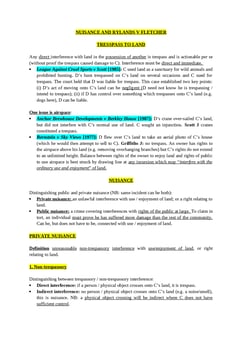Baker v Willoughby [1970] AC 467
Judgement for the case Baker v Willoughby
Table Of Contents
Plaintiff walked into the middle of the road and Defendant, driving, ran into him, causing damage to Plaintiff’s leg. They both saw each other over 200 yards and neither took evasive action.
The fault was ruled to be 25% Plaintiff’s and 75% Defendant’s.
Shortly after the accident Plaintiff was shot in the leg and it had to be amputated immediately.
HL held that the subsequent shooting was irrelevant to the amount of damages that Defendant had to pay, and that Defendant would have to pay the value of 25% of the damage to the leg overall (i.e. NO reduction despite the fact that Defendant did not cause the leg to be shot and amputated).
The shooting and car accident were to be treated as concurrent causes of the disability and each was liable for the full damage to the leg, i.e. that Defendant should have to pay the full amount for the long term damage he would have caused (had there been no shooting) despite the fact that Plaintiff would have been shot anyway (and Plaintiff’s actions made irrelevant).
Lord Pearson
We should take a “unitary and comprehensive” view of the original injury, assessing it as a “devaluation” in the leg, for which the responsible party should pay (though only for the proportion of the devaluation for which he was responsible).
The only thing that could change the amount to be paid is a reduction in the extent of the devaluation e.g. an unexpected recovery OR a shortening of Plaintiff’s life expectancy i.e. the period over which the plaintiff will suffer from the devaluation. If another tort occurs then the new tortfeasor will be liable for the further devaluation.
The life-shortening point is supported by the fact that if an injury costs Plaintiff 20 years working income by destroying his capacity to work, and then after only 1 year Plaintiff dies of an unrelated event, it would be unfair to make Defendant pay for 20 years since this would no longer be compensation.
Lord Reid
There were 2 concurrent causes of Plaintiff’s disability and both tortfeasors should have to pay for the suffering they cause.
----
This seems logical: The “but for” test would support Lord Reid’s conclusion since even “but for the shooting” Plaintiff would still be disabled. The correct approach is that adopted: to say that each party has to pay for the “devaluation” that they cause, making a qualification for cases where the extent of the devaluation has been reduced by something, for example a wonder-cure: this qualification is made by Lord Pearson.
The shooting does not absolve Plaintiff of responsibility for disabling Defendant, since even without the shooting Defendant would still have been disabled: it merely aggravated the situation.
RELATED CASES
For Further Study on Baker v Willoughby
Need instant answers? Our AI exam tutor is here to help.
Ask questions 🙋 Get answers 📔 It's simple 👁️👄👁️
Our AI is educated by the highest scoring students across all subjects and schools. Join hundreds of your peers today.
Get StartedSimilar Cases
Related Product Samples
These product samples contain the same concepts we cover in this case.
| Tort Law | Causation Notes (15 pages) |

 Since 2010, Oxbridge Notes has been a trusted education marketplace, supplying high-quality materials from top achievers at universities like Oxford, Cambridge, LSE, Harvard, and Yale.
Since 2010, Oxbridge Notes has been a trusted education marketplace, supplying high-quality materials from top achievers at universities like Oxford, Cambridge, LSE, Harvard, and Yale.